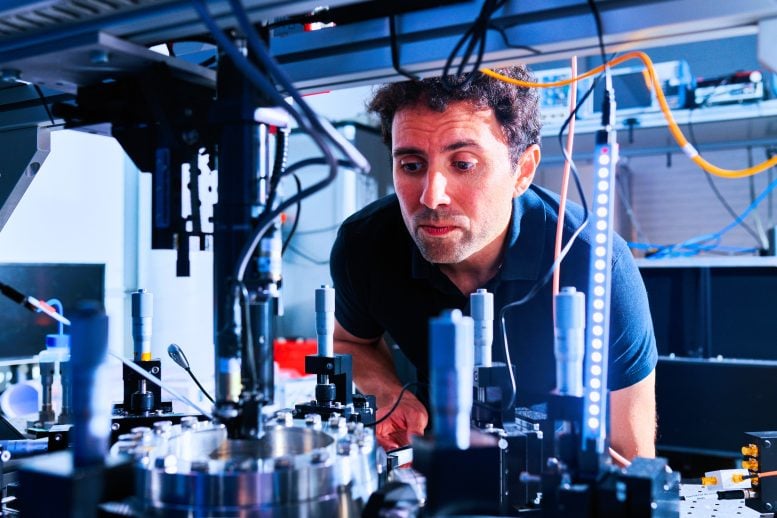
Artist impression of new nanostrings that can vibrate for a very long time. These nanostrings vibrate more than 100,000 times per second. Because it’s difficult for energy to leak out, it also means environmental noise is hard to get in, making these some of the best sensors for room temperature environments. Credit: Richard Norte
Researchers from TU Delft and Brown University have developed string-like resonators that can vibrate longer at ambient temperature than any other known solid-state object.
Researchers from TU Delft and Brown University have developed string-like resonators that can vibrate longer at ambient temperature than any other known solid-state object, nearing the performance typically only seen near
This innovation is pivotal for studying macroscopic quantum phenomena at room temperature—environments where such phenomena were previously masked by noise. While the weird laws of quantum mechanics are usually only seen in single atoms, the nanostrings’ ability to isolate themselves from our everyday heat-based vibrational noise allows them to open a window into their own quantum signatures; strings made from billions of atoms. In everyday environments, this kind of capability would have interesting uses for quantum-based sensing.

Professor Richard Norte in his lab at the Faculty of Mechanical Engineering of Delft University of Technology. Credit: Studio Wavy for Delft University of Technology
Extraordinary match between simulation and experiment
“Our manufacturing process goes in a different direction with respect to what is possible in nanotechnology today,” said Dr. Andrea Cupertino, who spearheaded the experimental efforts. The strings are 3 centimeters long and 70 nanometers thick, but scaled up, this would be the equivalent of manufacturing guitar strings of glass that are suspended half a kilometer with almost no sag. “This kind of extreme structures are only feasible at nanoscales where the effects of gravity and weight enter differently. This allows for structures that would be unfeasible at our everyday scales but are particularly useful in miniature devices used to measure physical quantities such as pressure, temperature, acceleration and magnetic fields, which we call MEMS sensing,” explains Cupertino.
The nanostrings are crafted using advanced nanotechnology techniques developed at the TU Delft, pushing the boundaries of how thin and long suspended nanostructures can be made. A key of the collaboration is that these nanostructures can be made so perfectly on a microchip, that there is an extraordinary match between simulations and experiments – meaning that simulations can act as the data for machine learning algorithms, rather than costly experiments. “Our approach involved using machine learning algorithms to optimize the design without continuously fabricating prototypes,” noted lead author Dr. Dongil Shin, who developed these algorithms with Miguel Bessa. To further enhance efficiency of designing these large detailed structures, the machine learning algorithms smartly utilised insights from simpler, shorter string experiments to refine the designs of longer strings, making the development process both economical and effective.
According to Norte, the success of this project is a testament to the fruitful collaboration between experts in nanotechnology and machine learning, underscoring the interdisciplinary nature of cutting-edge scientific research.
Inertial navigation and next-generation microphones
The implications of these nanostrings extend beyond basic science. They offer promising new pathways for integrating highly sensitive sensors with standard microchip technology, leading to new approaches in vibration-based sensing. While these initial studies focus on strings, the concepts can be expanded to more complex designs to measure other important parameters like acceleration for inertial navigation or something looking more like a vibrating drumhead for next-generation microphones. This research demonstrates the vast array of possibilities when combining nanotechnology advances with machine learning to open new frontiers in technology.
Reference: “Centimeter-scale nanomechanical resonators with low dissipation” by Andrea Cupertino, Dongil Shin, Leo Guo, Peter G. Steeneken, Miguel A. Bessa and Richard A. Norte, 18 May 2024, Nature Communications.DOI: 10.1038/s41467-024-48183-7